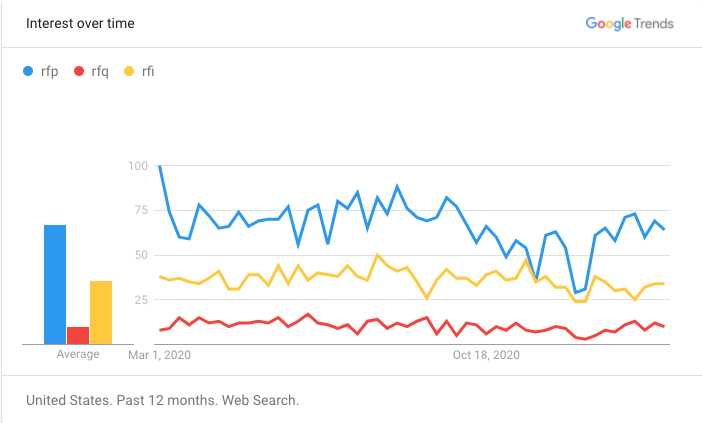RFP vs RFQ vs RFI - What Do They Mean, and What Is the Difference?
You're about to write a Request for X... what's the right name to use, and does it matter?

RFP, RFQ, RFI... the TL;DR
The terms "RFQ", "RFP", and "RFI" get thrown around a lot. And just like any other three-letter-acronym (TLA) in the corporate world, they often get misused and misunderstood.
We're here to explain the meaning and the key differences between these related, yet distinct, business tools.
Let's start with the basic definitions:
RFP: Request for Proposal
RFQ: Request for Quotation
RFI: Request for Information
Now if you're a nerd like me, you'll be curious which one is most commonly used. And for that, we turn to Google Trends.
The chart below shows the Google search volume over the last 12 months for each of the terms (as of March 1, 2021). While certainly not a perfect way to quantify their overall use, it's something, at least.

You'll see that RFP is the most commonly searched term of the three, with about 7x the search volume compared to RFQ, and more than 2x the search volume of RFI. Interesting, huh?
They popularity of RFP over the others is probably because this term is used across many industries, and is extremely flexible in its meaning and use. We'll explore more about that below.
The RFP - Request for Proposal
The RFP (Request for Proposal) is a very generally applied practice across the modern business world, used as a tool for organizations to make more informed buying decisions.
The buying party (a company, government organization, or other entity) will create a written document, or set of documents, that contains all the details of "what" they need to buy, including specifications, key milestones, cost expectations, and other requirements.
The buying party will then send this RFP, or RFP "package", to the vendors they'd like to get proposals from to fill their need. The vendor proposals are generally expected to have information on pricing, assigned resources, timelines, and whether or not they meet all the requirements set in the RFP.
Examples of when RFPs are used range anywhere from a small company buying a new CRM tool, to a Fortune 500 company hiring a new advertising agency, up to large multi-year government projects worth hundreds of millions of dollars.
As a result, RFPs can greatly vary in length and depth, ranging from a simple one-page outline, to a 500+ page highly-detailed document for the large, complex project example. The "right" length really depends on your industry and project scope.
Generally speaking, RFPs are used by buyers for things that are either larger in scope (ie: lengthy projects) or for when the thing being purchased is generally defined but still allows for and expects some differences between solutions on the market, as proposed by the responding vendors.
The RFQ - Request for Quotation
RFQs, on the other hand, are typically used when the thing being purchased is very specific and well-defined, and the expected response is also more quantitative than qualitative (ie: just a price quote). They are often used when buying physical things, rather than services or large-scale projects.
RFQs often include detailed product or component specifications, often technical in nature. Schedules, cost targets, and other details are often clearly defined.
RFQs are often used for outsourcing of specific work, or subcontracted manufacturing. In these cases, the buyer knows exactly what they want, using the RFQ as a way to find the lowest bid from a qualified supplier.
As a result, RFQs are more commonly used in direct-material procurement, where a buyer is sourcing components or materials that are used in the products they sell.
Typical use cases for RFQs could include an engine manufacturer soliciting bids for a stamped metal component, a construction company soliciting bids for 2x4s from multiple lumber yards, or an electronics OEM searching for the best price for semiconductor components.
While RFQs are generally more specific in nature than their RFP or RFI cousins, they can still be highly complex. For example, a buyer may have a long list of items they need quoted all at once, or all from the same vendor, calling for a multi-line RFQ. Managing and analyzing these complex RFQs can be time-consuming and labor-intensive, making them a perfect fit for the sourcing automation tools we've created here at Supplios.
The RFI - Request for Information
The Request for Information generally falls on the opposite side of the spectrum as the RFQ -- often even less specific than an RFP.
RFIs are even sometimes used before something like an RFP, as a tool for a buyer to initially survey the market and research what solutions are even available. Then later, once the project scope has been narrowed and requirements are better defined, the buyer may run a separate RFP to solicit more detailed and specific proposals.
Perhaps a company is surveying the market for a new type of consultant they need to hire, but they don't even know what their options are, or how possible vendors typically structure their offerings? That could be a good use for an RFI.
Do the different names matter?
The specific nomenclature you use to describe your Request for X really does not matter.
In the end, as a buyer, your goal should be to clearly communicate what you need, in as much or as little detail as you currently have, and to give your prospective sellers a fair chance to present their solution.
Should you call it an RFQ, RFP, or RFI? Pick whichever one "sounds right" for what you have, and go with that. You could even call it something completely different, like a RFBOP (a Request for Barrels of Potatoes). But at least picking one of the three most common terms will communicate your general intent.
All too often, we see people get stuck on the specific name, the specific format, and even the specific font to use on the RFX. But none of that really matters.
Far, far more important is the actual content, the speed at which you can solicit, screen, and select vendors, and your ability to make fair, fact-based decisions on the information you collect. The fact you're using Times New Roman instead of Helvetica font won't get you any closer to your end goal of buying the best quality at the lowest prices.
Here at Supplios, we make easy-to-use tools to help you do just that. Whether you are running an RFQ, RFP, RFI, or even a RFBOP, we've got you covered.
We help you create better RFXs, in less time, involving more suppliers, resulting in more competition and better outcomes... all with less work on your side. That's a bold statement, but if you give it a try, we think you'll agree.